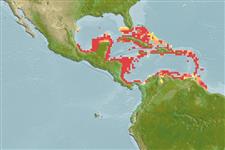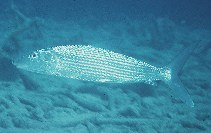إضافة ملاحظاتك Fish Watcher
| Native range | All suitable habitat | Point map | Year 2050 |

|
| This map was computer-generated and has not yet been reviewed. |
| Albula vulpes AquaMaps Data sources: GBIF OBIS |
ارفع صور و مقاطع فيديو
Pictures | Videos | Sounds | Stamps, coins, misc. | صور قوقلAlbula vulpes
Picture by Randall, J.E.
Pictures | Videos | Sounds | Stamps, coins, misc. | صور قوقلAlbula vulpes
Picture by Randall, J.E.
Common names from other countries
التصنيف / Names الأسماء الشائعة | مرادفات | Catalog of Fishes(جنس, الانواع) | ITIS | CoL | WoRMS | Cloffa
> Albuliformes (Bonefishes) > Albulidae (Bonefishes) > Albulinae
Etymology: Albula: Latin, albus = white (Ref. 45335).
More on author: Linnaeus.
Etymology: Albula: Latin, albus = white (Ref. 45335).
More on author: Linnaeus.
Environment: milieu / climate zone / depth range / distribution range البيئة
بحري; مياه مخلوطة مرتبطة بالشعاب; مهاجرة بين الياه الملحه و الحلوة لكن ليس للتزاوج (Ref. 51243); نطاق العمق 0 - 84 m (Ref. 13608), usually 1 - 15 m (Ref. 9268). Subtropical; 26°N - 7°N, 97°W - 58°W (Ref. 118624)
التوزيع دول | مناطق الفاو | النظام البيئي | الظهور | Point map | مقدمة | Faunafri
Worldwide in warm seas. Hawaiian species have been verified by electrophoretic analysis (Ref. 5577), hence, Albula vulpes might be further split. Eastern Pacific: California, USA to Peru (Ref. 2850). Western Atlantic: North Carolina, USA to Florida, Bahamas, Gulf of Mexico, Antilles and Caribbean to Brazil (Ref. 26938). Northwest Atlantic: Canada (Ref. 5951). The West African form is Albula goreensis, Valenciennes, 1846.
Length at first maturity / الحجم / وزن / العمر
Maturity: Lm 37.5, range 21 - 36 cm
Max length : 104 cm TL ذكر/ مختلط الجنس; (Ref. 7251); أعلا وزن تم نشرة: 10.0 kg (Ref. 37955)
Max length : 104 cm TL ذكر/ مختلط الجنس; (Ref. 7251); أعلا وزن تم نشرة: 10.0 kg (Ref. 37955)
وصف مختصر مفاتيح التعريف | الوصف الخارجي | قياسات المظهر الخارجي
الأشواك الظهرية (المجموع) : 0; الأشعة الظهرية الناعمة (المجموع) : 15 - 19; شوكة شرجية: 0; أشعه شرجية لينه: 7 - 9; فقرات: 69 - 74. Branchiostegal rays 12-14 (Ref. 4639). Silvery with dusky fins; base of pectorals yellow (Ref. 3970). Body elongate and fusiform (Ref. 4832). Last ray of dorsal and anal fins not prolonged; head region naked; spot and band absent on head; margin of nasal pore not black (Ref. 13608). Bluntly conical snout extends beyond inferior mouth (Ref. 26938). Pectoral and pelvic axillary scales present; a single long scale on each side of membrane between each ray of dorsal and anal fins (Ref. 4832).
Inhabits shallow coastal waters, estuaries and bays, over sand and mud bottoms (Ref. 3237). Often in schools, except large individuals which are solitary (Ref. 7251). Dorsal fin may show above surface (Ref. 42064). More or less pelagic but feeds on benthic worms, crustaceans, and mollusks (Ref. 2850); that are picked from mud and sand bottoms (Ref. 27549). Tolerates oxygen poor water by inhaling air into a lung-like airbladder (Ref. 9710). Flesh is bony and not esteemed (Ref. 9268). One of the most important game fishes worldwide (Ref. 26938).
Life cycle and mating behavior النضج | التكاثر | وضع البيض | بيض | الخصوبة | Larvae
Spawning occurs in open waters. Eggs are pelagic (Ref. 205).
المرجع الرئيسي
Upload your references | مراجع | المنظم | المتعاونين
Whitehead, P.J.P., 1990. Albulidae. p. 122-124. In J.C. Quero, J.C. Hureau, C. Karrer, A. Post and L. Saldanha (eds.) Check-list of the fishes of the eastern tropical Atlantic (CLOFETA). JNICT, Lisbon; SEI, Paris; and UNESCO, Paris, Vol. 1. (Ref. 4447)
IUCN Red List Status (Ref. 130435: Version 2024-2)
قريب من التهديد بالخطر (NT) ; Date assessed: 29 March 2011
استخدامات بشرية
مصائد: غير مهمة تجارياً; لعبة سمكه: نعم; طعم: usually
FAO(مصائد: الأنتاج; publication : search) | FishSource | البحر حولنا
مزيد من المعلومات
Population dynamics
معاملات النمو
Max. ages / sizes
Length-weight rel.
Length-length rel.
الطول- الترددات
Mass conversion
توظيف
الوفرة
معاملات النمو
Max. ages / sizes
Length-weight rel.
Length-length rel.
الطول- الترددات
Mass conversion
توظيف
الوفرة
Anatomy
منطقة الخياشيم
Brain
Otolith
منطقة الخياشيم
Brain
Otolith
Physiology
Body composition
Nutrients
استهلاك الأوكسجين
نوع السباحة
سرعة السباحة
Visual pigments
Fish sound
Diseases & Parasites
Toxicity (LC50s)
Body composition
Nutrients
استهلاك الأوكسجين
نوع السباحة
سرعة السباحة
Visual pigments
Fish sound
Diseases & Parasites
Toxicity (LC50s)
Genetics
جيني
Heterozygosity
التوريث
جيني
Heterozygosity
التوريث
Human related
Aquaculture systems
ملامح تربية الأحياء المائية
سلالات
Ciguatera cases
Stamps, coins, misc.
Aquaculture systems
ملامح تربية الأحياء المائية
سلالات
Ciguatera cases
Stamps, coins, misc.
أدوات
Bio-Quiz | E-book | دليل الميدان | مفاتيح التعريف | Length-frequency wizard | أداة تاريخ الحياة | نقطة علي الخريطة | Classification Tree
| Catch-MSY |
تقارير خاصة
البحث عن صيانت الأحواض المائيه | التحقق من وجود صفحات حقائق الأنواع | البحث عنا حقائق حول الأحواض المائيه
Download XML
مصادر علي الأنترنت
Alien/Invasive Species database | Aquatic Commons | BHL | Cloffa | Websites from users | البحث في مراقبي الأسماك | CISTI | Catalog of Fishes(جنس, الانواع) | DiscoverLife | ECOTOX | Faunafri | Fishtrace | GenBank(الوراثة, نيوكلوتيدة) | GloBI | GOBASE | GoMexSI (interaction data) | | Google Books | Google Scholar | Google | IGFA World Record | MitoFish | قاعدة البينات الوطنية | Otolith Atlas of Taiwan Fishes | PubMed | Reef Life Survey | Scirus | SeaLifeBase | شجرة الحياة | Wikipedia(ذهب, بحث) | World Records Freshwater Fishing | سجلات علم الحيوانات
Estimates based on models
Preferred temperature (Ref. 115969): 20.4 - 28.4, mean 27 (based on 1501 cells).
Phylogenetic diversity index (Ref. 82804): PD50 = 0.5007 [Uniqueness, from 0.5 = low to 2.0 = high].
Bayesian length-weight: a=0.01230 (0.00895 - 0.01691), b=3.02 (2.93 - 3.11), in cm Total Length, based on LWR estimates for this species (Ref. 93245).
مستوى غذائي (Ref. 69278): 3.7 ±0.3 se; based on diet studies.
المرونه (Ref. 120179): منخفض, الحد الزمني الأدني لتضاعف عدد أفراد المجتمع 4.5-14 سنة (K=0.3; tm=2; tmax=20).
Fishing Vulnerability (Ref. 59153): Moderate vulnerability (40 of 100).
Climate Vulnerability (Ref. 125649): High to very high vulnerability (66 of 100).




